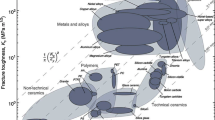Abstract
An investigation of the evolution of the stress-strain curve during deformation in torsion has been carried out. The stress first increases to a narrow plateau, followed by a decrease in flow stress of about 20 pct until steady state is reached. In order to determine the factors that are responsible for the fall in flow stress, investigations of the microstructure and texture were made. The subgrain size was found to increase by about 20 pct corresponding to a fall in the flow stress of about 10 pct. The texture was found to change from a close to random texture at the peak of the flow stress to a texture mainly consisting of the components {001}〈110〉 and {112}〈110〉 at the strain where the stress-strain curve reaches the second steady state. A fall in the flow stress of about 5 pct could be ascribed to changes in texture occurring during deformation.
Similar content being viewed by others
References
M.E. Kassner, M.M. Myshlyaev, and H.J. McQueen: Mater. Sci. Eng., 1989, vol. A108, pp. 45–61.
M.E. Kassner and J.J. Oldani: Proc. 9th Inter-American Conf. on Materials Technology, 1987, Universtovia, Santiago, Chile, pp. 219–223
B. Rønning: Thesis, Norwegian Institute of Science and Technology, 1998.
T. Pettersen: Ph.D. Thesis, Norwegian University of Science and Technology, Trondheim, 1999.
C.M. Sellars and W.J. McGregor Tegart: Int. Met. Rev., 158, 1972, vol. 17, pp. 1–24.
T. Pettersen and E. Nes: Metall. Mater. Trans. A, 2003, vol. 34A, pp. 0000–00.
F. Montheillet, M. Cohen, and J.J. Jonas: Acta Metall., 1984, vol. 32 (11), pp. 2077–89.
H.J. McQueen, J.K. Solberg, N. Ryum, and E. Nes: Phil. Mag. A, 1989, vol. 60, pp. 473–85.
J.K. Solberg, H.J. McQueen, N. Ryum, and E. Nes: Phil. Mag. A, 1989, vol. 60, pp. 447–71.
H.J. McQueen, O. Knustad, N. Ryum, and J.K. Solberg: Scripta Metall., 1985, vol. 19, pp. 73–78.
J. Driver: personal communication, Ecole Des Mines De Saint Etienne, Saint Etienne, France, 1998.
G.R. Canova, S. Shrivastava, J.J. Jonas, and C. G’Sell: Formability of metallic materials—2000 A.D., ASTM Special Technical Publication, ASTM, Philadelphia, PA, 1982, pp. 189–210.
S.C. Shrivastava, J.J. Jonas, and G. Canova: J. Mech. Phys. Solids, 1982, vol. 30, pp. 75–90.
Ch. Perdrix, M.Y. Perrin, and F. Montheillet: Mém. Etudes Sci. Rev. Métall., 1981, pp. 309–20.
M.E. Kassner and M.E. McMahon: Metall. Trans. A, 1987, vol. 18A, pp. 835–46.
E. Nes and K. Marthinsen: Mater. Sci. Eng., 2002, vol. A322, p. 176.
Author information
Authors and Affiliations
Rights and permissions
About this article
Cite this article
Pettersen, T., Nes, E. On the origin of strain softening during deformation of aluminum in torsion to large strains. Metall Mater Trans A 34, 2727–2736 (2003). https://doi.org/10.1007/s11661-003-0174-1
Received:
Issue Date:
DOI: https://doi.org/10.1007/s11661-003-0174-1




